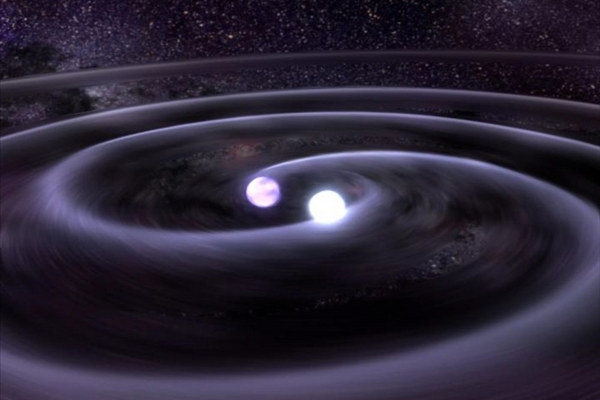Gravitational Wave Rumors Rumble Social Media

In the roller-coaster rumor mill that surrounds some of the biggest physics endeavors of our time, it pays to remain skeptical when extraordinary claims of historic discoveries are made on social media.
In a tweet by Lawrence Krauss this morning, the well-known Arizona State University theoretical physicist and cosmologist wrote: “My earlier rumor about LIGO has been confirmed by independent sources. Stay tuned! Gravitational waves may have been discovered!! Exciting.”
Top 10 Space Stories of 2015: Readers’ Choice
In September, Krauss hinted that LIGO — the Laser Interferometer Gravitational Wave Observatory — had detected signs of elusive gravitational waves. “Rumor of a gravitational wave detection at LIGO detector. Amazing if true. Will post details if it survives,” he tweeted on Sept. 28, 2015.
The detector, which is split between two locations in Louisiana and Washington,has recently undergone a sensitivity upgrade, so hopes are high that the hard-to-find space-time wiggles may finally be directly detected, perhaps heralding a new era of gravitational wave astronomy.
It is thought that any acceleration of massive objects in the universe will generate gravitational waves. Black hole and neutron star collisions, supernovae and galactic mergers are all thought to be huge sources of gravitational waves; if we can somehow detect and, indeed, map them we could reveal some of the most massive objects and most energetic events in the cosmos.
ANALYSIS: Faster-Than-Light Neutrinos Caused by Loose Cable?
Get the Space.com Newsletter
Breaking space news, the latest updates on rocket launches, skywatching events and more!
The theoretical basis for gravitational waves spawn from general relativity equations that were formulated by Albert Einstein over 100 years ago. Although there is indirect evidence of gravitational waves carrying away energy from orbiting bodies (through extended observations of binary pulsar and white dwarf systems), the detection of the extremely slight impact of the propagation of gravitational waves that are hypothetically washing though our planet has been maddeningly difficult to achieve.
The LIGO stations use extremely fine-tuned laser interferometers to detect the passage of gravitational waves (that can be imagined as ripples in spacetime, much like the ripples that propagate across the surface of a pond) and only weeks before Krauss’ original tweeted rumor had embarked on a new phase of sophistication, called Advanced LIGO.
Now, Krauss may well be directly involved with the analysis of LIGO data and hecould be privy to an exciting finding that may indicate a LIGO detection of gravitational waves, but until rigorous 3rd party studies are completed and studies are published in peer reviewed journals, it is hard to make solid conclusions about what has (or indeed hasn’t) been discovered by LIGO.
ANALYSIS: Why Is This ‘Naked’ Black Hole on a Crash Diet?
As pointed out by Jennifer Ouellette at Gizmodo, until we get any official word from LIGO, we just have to be patient and avoid jumping the gun when hearing rumors circulating on social media.
Gravitational waves haven’t been far from the headlines in recent years. In 2014,announcements were made that the South Pole-based telescope BICEP2 had detected signals in the cosmic microwave background (CMB) of primordial gravitational waves, thereby confirming some Big Bang and inflationary models. However, the announcement was made prematurely and it quickly became clear that the BICEP2 signal was a dud. Observations by the European Planck space telescope revealed that, in fact, the signal was caused by obscuring dust in our galaxy, not by gravitational waves etched into radiation generated at the furthest-most reaches of the universe. Bummer.
Even scientists can let excitement get the better of them, and while rumors are a part of human nature, social media rapidly boosts the virility of these rumors that can quickly be misconstrued as fact.
ANALYSIS: BICEP2 Gravitational Wave ‘Discovery’ Deflates
So as we await official word about Krauss’ gravitational wave “discovery” tweets, it pays to be patient. The discovery of gravitational waves may well happen soon (and many scientists are pinning hopes on 2016 as being “the” year for a detection by Advanced LIGO), but it has taken us decades to get this far, let’s wait for proof that these mysterious wiggles in spacetime have finally been tracked down.
h/t Gizmodo
Originally published on Discovery News.
Join our Space Forums to keep talking space on the latest missions, night sky and more! And if you have a news tip, correction or comment, let us know at: community@space.com.
Ian O'Neill is a media relations specialist at NASA's Jet Propulsion Laboratory (JPL) in Southern California. Prior to joining JPL, he served as editor for the Astronomical Society of the Pacific‘s Mercury magazine and Mercury Online and contributed articles to a number of other publications, including Space.com, Space.com, Live Science, HISTORY.com, Scientific American. Ian holds a Ph.D in solar physics and a master's degree in planetary and space physics.









